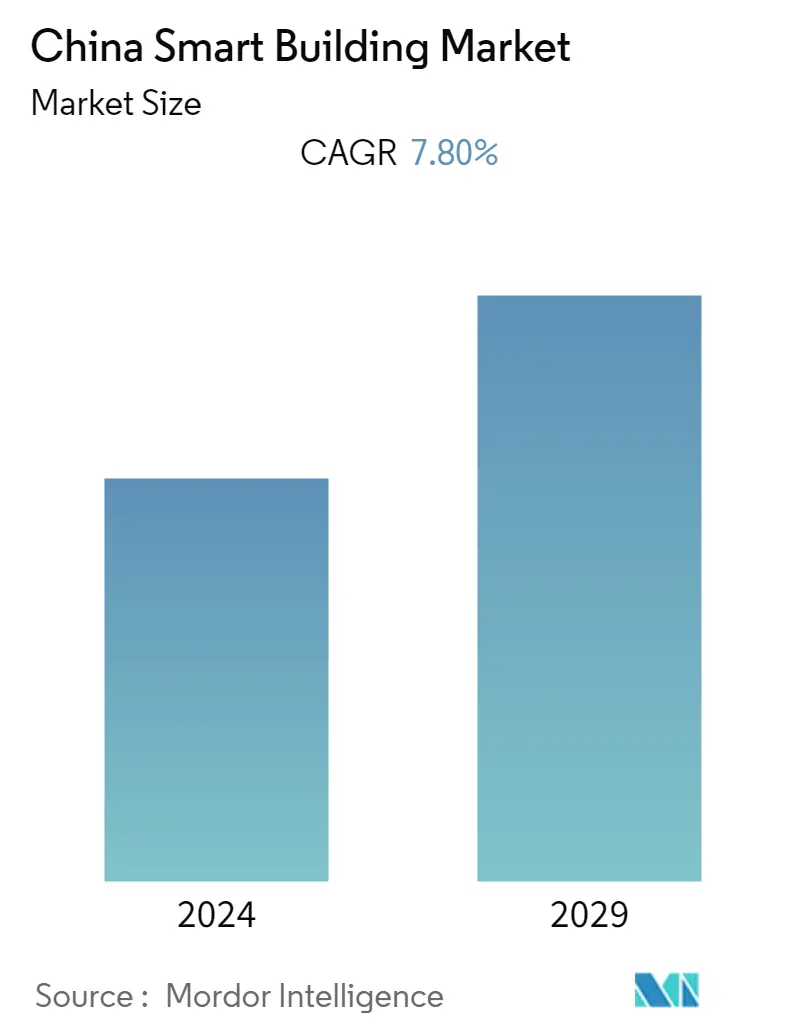Market Size of China Smart Building Industry

| Study Period | 2019 - 2029 |
| Base Year For Estimation | 2023 |
| Forecast Data Period | 2024 - 2029 |
| Historical Data Period | 2019 - 2022 |
| CAGR | 7.80 % |
| Market Concentration | Medium |
Major Players
*Disclaimer: Major Players sorted in no particular order |
China Smart Building Market Analysis
The China Smart Building Market is expected to grow at a CAGR of 7.8% over the forecast period (2022 - 2027). The consumer's propensity to adopt security solutions is rising due to the pandemic scenario and the uncertainty of returning to normal life. The aspect of a 'smart building' is looking more practical in the 'new normal' post-COVID-19 in the country. It is not about efficiency or smart usages like smart options of switching on a luminaire or an HVAC, but the practical reality of ensuring fewer instances of touching, if not doing away altogether, off switches to switch on any appliance.
- A smart building automates its processes to control its infrastructure, lighting, security systems, heating, ventilation, and air conditioning systems. A smart building uses technology and assimilates it with the basic building infrastructure and other structural and equipment components to make buildings increasingly efficient, safer, sustainable, and reduce costs. The studied smart building solutions are part of the growing IoT and connected sensor ecosystem.
- Solutions, such as the Infrastructure Management System, Building Energy Management System, and Intelligent Security System, are currently being adapted for smart buildings. BEMS is an integrated and computerized system for monitoring and controlling energy-related building services, plants, and equipment such as HVAC systems and lighting.
- The adoption of smart technologies in the country could be accelerated by incentivizing the process and by setting up benchmarks. Smart technologies often incentivized through prescriptive utility energy efficiency programs include advanced occupancy and vacancy controls that work with lighting and HVAC systems, daylighting controls, smart power strips, smart plugs, and BMS.
- Moreover, the spike in energy consumption can be controlled by benchmarking. Property owners, facility operators, managers, and designers could use bench marketing to facilitate energy accounting, comparing a facility's energy use to similar facilities to assess opportunities for improvement and quantify/verify energy savings. Smart energy solutions have been adopted to meet the desired benchmark and reduce energy consumption.
- Moreover, the Chinese government frequently promotes smart city cooperation under its Digital Silk Road Initiative, a significant component of the Belt and Road Initiative (BRI). In ASEAN, cooperation is enhanced through the ASEAN-China Strategic Partnership Vision 2030, where China has pledged to support ASEAN's technology transformation initiatives, including the ASEAN ICT Master Plan 2020 and the ASEAN Smart City Network.
- Furthermore, recovery from COVID-19 further forces regional organizations to reimagine their operations for the next normal. Organizations across industries are adapting to emphasize digitalization and automation across their operations. Such changes are expected to impact the requirements for workforce skills and capabilities significantly. This will require two changes across the workforce: upskilling, in which staff gain new skills to help in their current roles, and reskilling, in which staff needs capabilities to take on different or entirely new functions.
China Smart Building Industry Segmentation
The study characterizes the smart building market based on the solution and building type. Solutions that automate and optimize the building's operations and performance are studied. A smart building is a building that automates its processes to control its infrastructure, lighting, security systems, heating, ventilation, air conditioning systems, and more.
A smart building uses technology to make buildings more efficient, sustainable, safer, and reduce costs. Smart building solutions are part of the growing IoT and connected sensor ecosystem. Further, key base indicators considered for the study are the adoption and penetration rate of smart solutions in homes, current trends, COVID-19, and several other key macroeconomic indicators.
| By Solution | |
| Building Energy Management System | |
| Infrastructure Management System | |
| Intelligent Security System | |
| Other Solutions |
| By Building Type | |
| Residential | |
| Commercial | |
| Industrial |
China Smart Building Market Size Summary
The China Smart Building Market is poised for substantial growth, driven by the increasing adoption of smart technologies and the integration of IoT solutions within building infrastructures. This market evolution is largely influenced by the need for enhanced security and efficiency in the wake of the COVID-19 pandemic, which has shifted consumer preferences towards solutions that minimize physical contact and optimize energy use. Smart buildings, which automate processes related to lighting, security, and HVAC systems, are becoming more prevalent as they offer improved safety, sustainability, and cost-effectiveness. The Chinese government's initiatives, such as the Digital Silk Road and the ASEAN-China Strategic Partnership, further bolster the market by promoting smart city developments and technological advancements across the region.
The competitive landscape of the China Smart Building Market is characterized by a moderate level of fragmentation, with numerous vendors offering a range of smart building solutions. Key players like Johnson Controls, Siemens Building Technologies, Honeywell International, Schneider Electric, and Hitachi Ltd are actively engaging in strategic partnerships and mergers to enhance their market presence. Recent innovations, such as Honeywell's cloud-based solutions and Siemens' updated smart building management platform, highlight the ongoing advancements in the sector. These developments, alongside the growing awareness and adoption of IoT-enabled infrastructure management systems, are expected to drive the market's expansion, offering significant opportunities for energy efficiency and operational optimization in both residential and commercial buildings.
China Smart Building Market Size - Table of Contents
-
1. MARKET SEGMENTATION
-
1.1 By Solution
-
1.1.1 Building Energy Management System
-
1.1.2 Infrastructure Management System
-
1.1.3 Intelligent Security System
-
1.1.4 Other Solutions
-
-
1.2 By Building Type
-
1.2.1 Residential
-
1.2.2 Commercial
-
1.2.3 Industrial
-
-
China Smart Building Market Size FAQs
What is the current China Smart Building Market size?
The China Smart Building Market is projected to register a CAGR of 7.80% during the forecast period (2024-2029)
Who are the key players in China Smart Building Market?
ABB Group, Honeywell International Inc., Johnson Controls Plc, Schneider Electric SE and Siemens Building Technologies (Siemens AG) are the major companies operating in the China Smart Building Market.

